O.R.B. Updated Preview
Strategy First's long overdue real-time strategy game is finally nearing completion. We've got new details, screenshots, and movies inside.
See it in Action!
What a difference a year makes. The last twelve months of O.R.B.'s development has allowed Strategy First's to evolve this real-time strategy game in every possible way. Looking in on a late beta build at the developer's Montreal studios last week revealed that the 3D real-time strategy epic has made huge strides from what were rather humble beginnings. A complete overhaul of the graphics, the addition of a detailed storyline with Biblical aspirations, and a reworked interface that emphasizes ease of use made us take a long second look at a title that has come a long way in a short period of time.
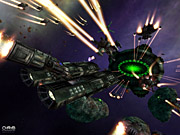
"O.R.B. has really changed since the last time we released a demo for the media," said producer Paul Gadbois on a rare break from a schedule that has predictably turned punishing as the game nears gold certification. "It frustrates me a little when I see people in newsgroups and Web forums saying bad things about the game, because they don't have any idea how much it has changed. They really don't know anything about this game at all. What they're familiar with doesn't exist anymore."
Gadbois seems to have a valid point. What we saw of O.R.B. bore little resemblance to the brief demo builds that made the media rounds from the summer of 2001 through last spring's E3. Presentation values are a lot higher now, placing this updated build on a level playing field with other contemporary real-time strategy games. This is most readily noticeable in the attention paid to the setting and atmosphere. The story of the Malus and Alyssians has been fleshed out, so they are more than just generic alien races who go to war upon discovering that they share a solar system. An epic story involving an ancient holy book called the Torumin has been woven into the single-player campaign. This tome reveals much of the shared background of the two races, although there are key differences that make them distrust one another. The Malus, in particular, are fearful of the Alyssians because they assume that their neighboring civilization represents the "Great Deceiver" of the Torumin.
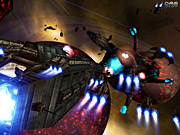
This tale is bolstered by strong cinematics. Cutscenes using the game engine currently preface all of the campaign missions, and they do an admirable job of establishing a space opera atmosphere. Scripture from the differing versions of the Torumin is often used to set a forbidding tone, in a way that is somewhat reminiscent of the ominous quotes that Looking Glass sprinkled throughout the Thief games. So even though O.R.B. takes place among the stars and features futuristic alien races, the creators seem to have established an almost gothic mood. A certain quality in the storytelling makes the demo build stand out from your garden-variety RTS in space.
Attractive graphics reinforce this unique look, so you likely won't confuse O.R.B. with any other game. Ship design appears to be more industrial than that seen in other space-based strategy titles. Both Malus and Alyssian vessels are intended to be seen as serviceable, not stylish, and are accordingly blocky. While this trait is particularly noticeable in the Malus fleet--appropriate because the race specializes in raw offensive and defensive power--even the sleeker Alyssian craft are the obvious result of assembly-line technology. Adding exotic spice is a mysterious alien race called the Kyulek. Strategy First wants to leave readers in the dark about this hostile species, as it plays an important role in the campaign plot, although it does appear that these aliens make their ships out of some organic material. Both the alien vessels and their bases certainly appeared to have been grown in the beta build. Ships from all three races make good use of lighting effects for weapon fire and engine exhaust. Gadbois showed us one large engagement that featured hundreds of flashes of colored light that rendered the scene equal parts fireworks display and equal parts battle.
What's Wrong With Homeworld?
Strategy First has also taken pains to give these ships a realistic setting in which to ply their trade. The backdrops that we saw seemed more fitting for a planetarium display than a computer game. Planets came in many different types, ranging from purple gas giants to volcanic wastelands glowing red with lava. All varieties turned in orbit around their suns and rotated through the day-night cycle. Storm systems could even be seen moving across the surfaces of more hospitable, Earth-like worlds. Even the asteroid belts were more than just fields of featureless rocks where you gather resources.
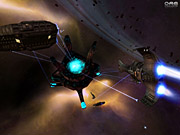
"We have really done a lot of work on the art in general and with planets and asteroids in particular," explained Gadbois during a tour of O.R.B.'s varied solar systems. "We have all sorts of different planets here. We've got ice worlds, fire worlds, you name it. Each map has a different planetary type. Asteroids also look different on each map, because we used lots of different textures. Some are heavily cratered, others are smooth, and others have what looks almost like designs carved into their surfaces."
Play options appear to stick closer to RTS fundamentals. Modes of play will include five tutorial missions, a solo campaign where you start playing as the Malus and eventually switch to the Alyssians, and a fully customizable skirmish option for two to eight human or AI players online or off, with team support provided. Four skirmish games will be included: Spaceport mode will outfit each player with a fixed base; carrier mode will start each player with a mobile carrier capital ship; carrier/portal mode will add a jumpgate portal to the previous mix; and structure mode will give each side a set number of irreplaceable units to use in a deathmatch. Many map types are scheduled to be included, based on crucial features like the distribution of asteroid resources, the rotation of planets and asteroids, and the location of fixed bases. All game types are set to be customizable. You will be able to adjust everything from the time required to build units to whether or not debris can cause damage to ships. It will even be possible to switch off resource gathering and assign each side an automatic resource replenishment rate.
The interface is reminiscent of previous RTS games set in the 3D environment of deep space, although there are some important changes here. Gadbois told us that the interface was one of the top priorities for his design team, as they wanted to steer clear of problems that made some of those earlier games difficult to use. "Nothing against Homeworld, as it was a great game, but too often it felt like you were fighting the game and not the enemy units on the screen. We've really focused on this and tried to make the design very simple for the player to pick up by sticking to just three primary keyboard keys and the mouse. We have really tried to provide a game that the player can just sit down and start playing," explained Gadbois.
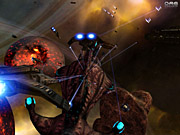
Playing the beta build was certainly an easy task. As Gadbois explained, all of the main functions were centered on the mouse and three keys. A right-click and hold allowed us to move the camera, while left-clicking selected units. We could zoom the camera in and out by using the mousewheel or by holding both mouse buttons down simultaneously. Many of the game's other functions were addressed by hitting the Ctrl, F, and T keys. Ctrl brought up the map grid for easy access to ship navigation over long distances, F focused the camera on the selected unit or units, and T turned on tracking mode to follow those units. Moving to a 2D map was as easy as pressing the spacebar. It seemed to have the same functionality as the default 3D screens and the additional 3D top-down view, although it allowed us to maneuver ships on the vertical access by adjusting a slider bar representing each vessel's current "altitude." But although the 2D option will be there, it might not really be needed. Players have traditionally had difficulty with maneuvering in 3D space sims, so Strategy First is addressing this problem by minimizing the need to move along a vertical axis in many missions. And even when you will need to move up or down to reach a particular point, you'll often be able to simply click on a vessel or asteroid to get to the desired destination.
Rocks in Space
Gameplay also looks to be fairly close to what people expect from an RTS game. The Malus and Alyssians will each come equipped with long lists of buildings and vessels to be constructed. Though the two races are being carefully balanced to be roughly equal in overall strength, the Malus deal in raw power and have superior weaponry for blunt attacks, while the pacifistic Alyssians prefer cloaking technology and speedy ships. There will be four separate vessel classes--fighter, capital, logistics, and mining--layered the same for each race but with a few unique offerings per side. Each appeared to be fully stocked in the beta build, with numerous types of each class available to be built. One of the most impressive frills that we saw was the size difference between these classes. Fighters were positively dwarfed by immense capital ships, adding a dramatic quality to large-scale engagements.
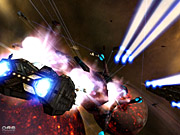
Each mission will begin with your race in possession of certain vessels and technologies, along with the need to research and construct improvements. Tech trees will be the same for both the Malus and the Alyssians. Six schools will be featured--energy, materials, construction, explosives, electronics, and academics. Each school will have one to eight avenues of investigation that involve different facets of the game. To build better beam weapons, for example, you'll specialize in energy. To build better torpedoes, you'll look into explosives. Academics will be a little different from the others, as research into its fields will increase your production of the manpower resource needed to helm your fleet. Prototypes will also need to be researched and built before you begin mass production of any new vessel.
O.R.B.'s only other resource comes in the form of asteroids. Each map will feature asteroid belts that have to be mined for resource points necessary to construct ships and bases. In addition to their value as mines, asteroids will also be open for the use of either side when you're looking to build a base. Basic mining platforms will be upgradable, leaving you the option to expand to a full-blown military headquarters with the ability to construct ships and set up orbital defense satellites. The one catch to all of this will be the asteroids' orbits. Planets and asteroids follow orbital paths around the sun, so you'll have to be aware not only of the current location of a resource-rich asteroid, but of where it is going to end up later in the game. What looks good in the immediate future might not seem so attractive down the road, when your favorite asteroid has rotated into enemy territory.
Other aspects of gameplay should also give O.R.B. a unique character. Vessels will default to their most logical function. So, for example, when you send a scout ship to an asteroid, it will automatically begin scanning for resources. Tactical combat is being emphasized over reflexive clicking through the use of doctrines that govern the behavior of each unit or group of units. You'll be able to put ships on stock aggressive, neutral, and defensive postures or select custom settings that let you do some fine-tuning. For instance, you could order a group of ships to be aggressive but to attack only when they're stronger than the enemy. Or you could order them to be defensive and return for refitting and repairs when damage reaches a certain threshold. Waypoints and resource supply routes will also be available, allowing you to back away from the hands-on control that makes many RTS games seem like carpal-tunnel clickfests.
"All of this is aimed at those who want to look at the game on a grand scale and not bother with micromanagement," said Gadbois. "Of course, if you want to get into the micromanagement and oversee every shot in every battle, you can turn off doctrines completely."
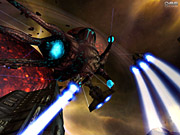
Added tactical depth will come from two surreptitious elements. You will be able to research spying and enlist secret operatives to go behind enemy lines. What these agents accomplish will be tied directly to the amount of time spent on developing them, although Gadbois promises that good things will come to the player who cultivates an interest in espionage. Almost any result could come from spying, from the assassination of enemy manpower to the theft of technology. It will also be possible to be sneaky during combat. Although the ability to hide amid debris and asteroids had to be removed because of system-requirement issues, you will be able to power down your vessels, which will make it much harder for the enemy to spot them with sensors. Seeing this in action was reminiscent of submarine combat, as the powered-down ship had access to a bar depicting the enemy's detection attempts. It was a lot like being pinged with sonar and was certainly every bit as tense.
Although the 3D engine and deep-space tactical engagements will make comparisons to Homeworld inevitable, what Strategy First showed us should make many of those comparisons favorable. At this late stage in the development process, O.R.B. looks like it might be a winning blend of the familiar and the innovative. You'll be able to find out for yourself when the game ships to stores in early November. Check back with GameSpot at that time for full review coverage.
Got a news tip or want to contact us directly? Email news@gamespot.com
Join the conversation